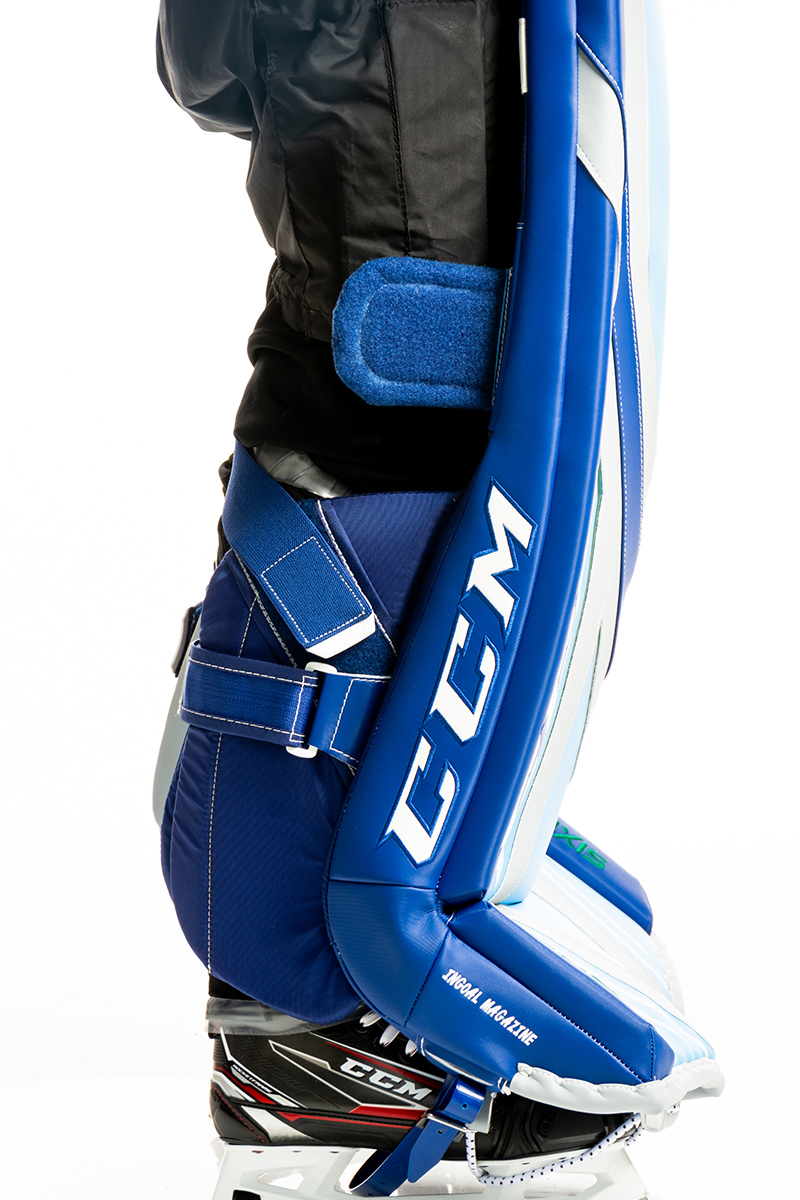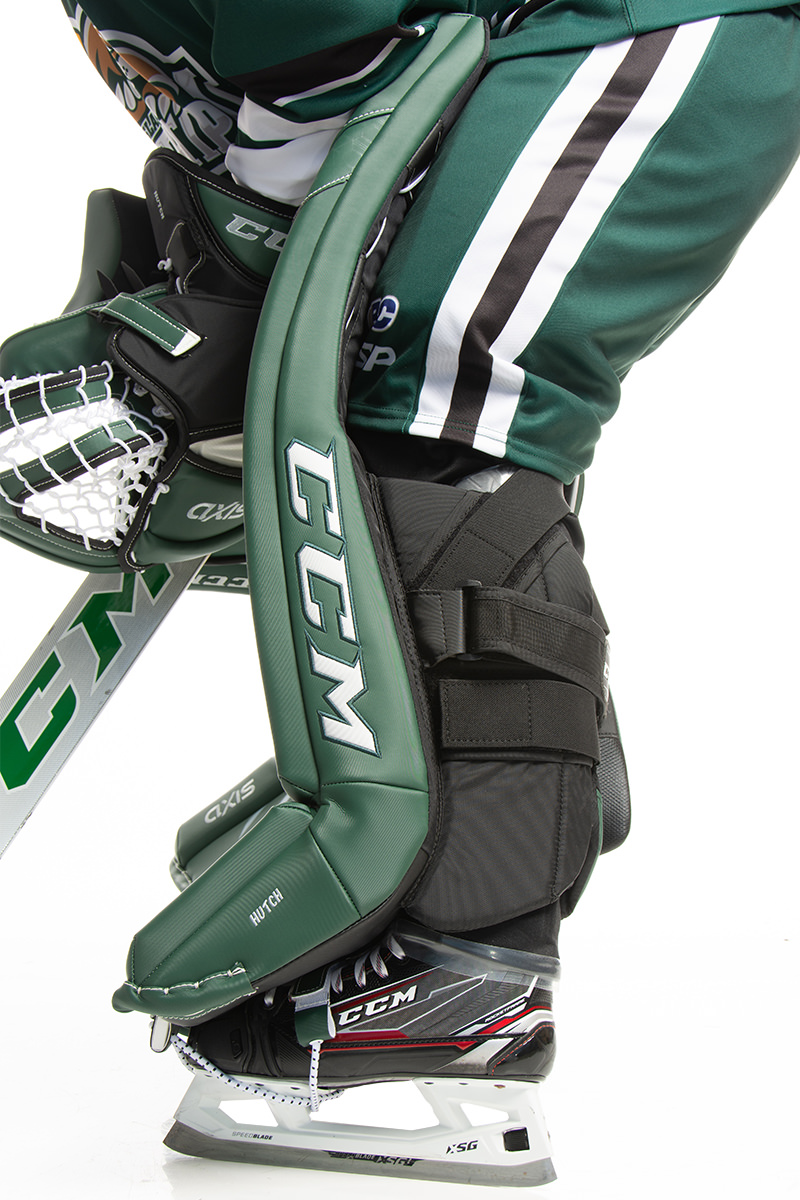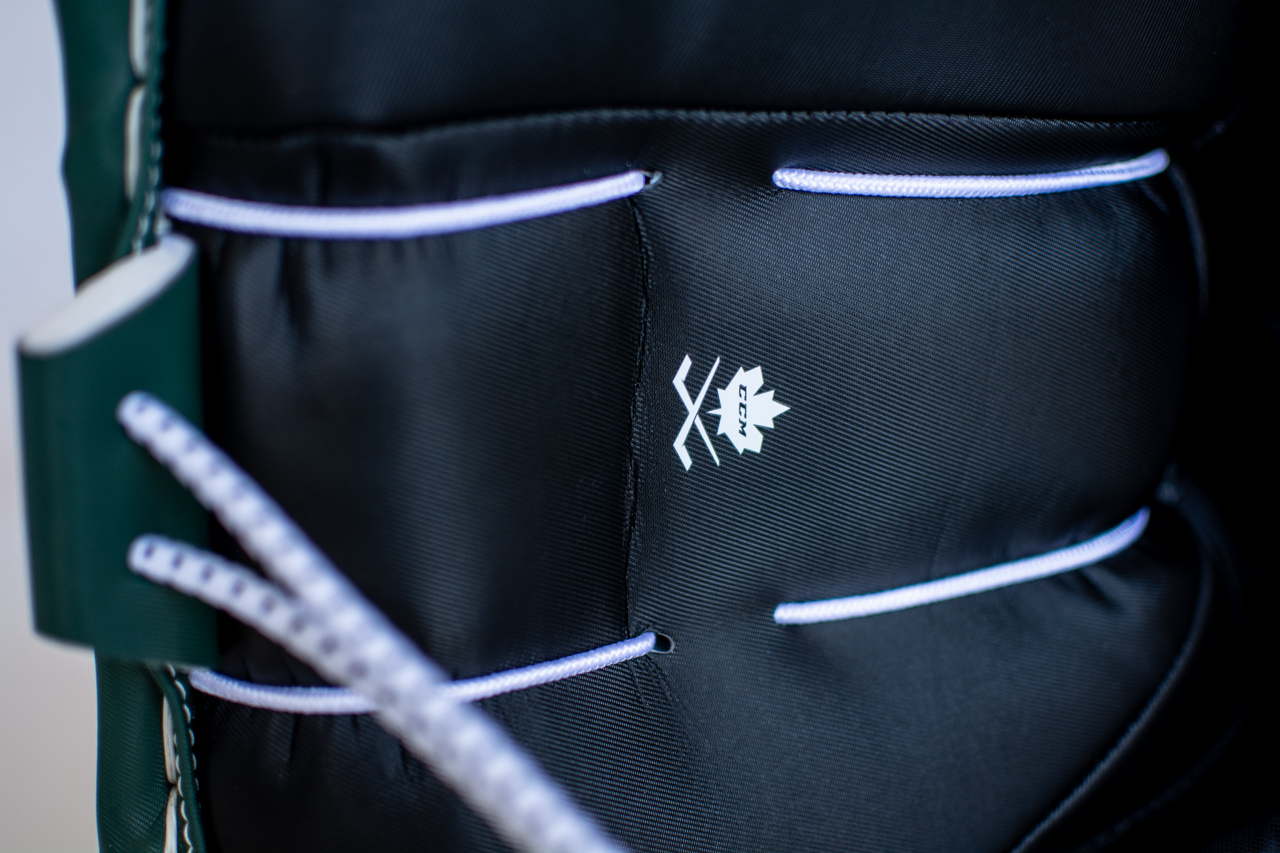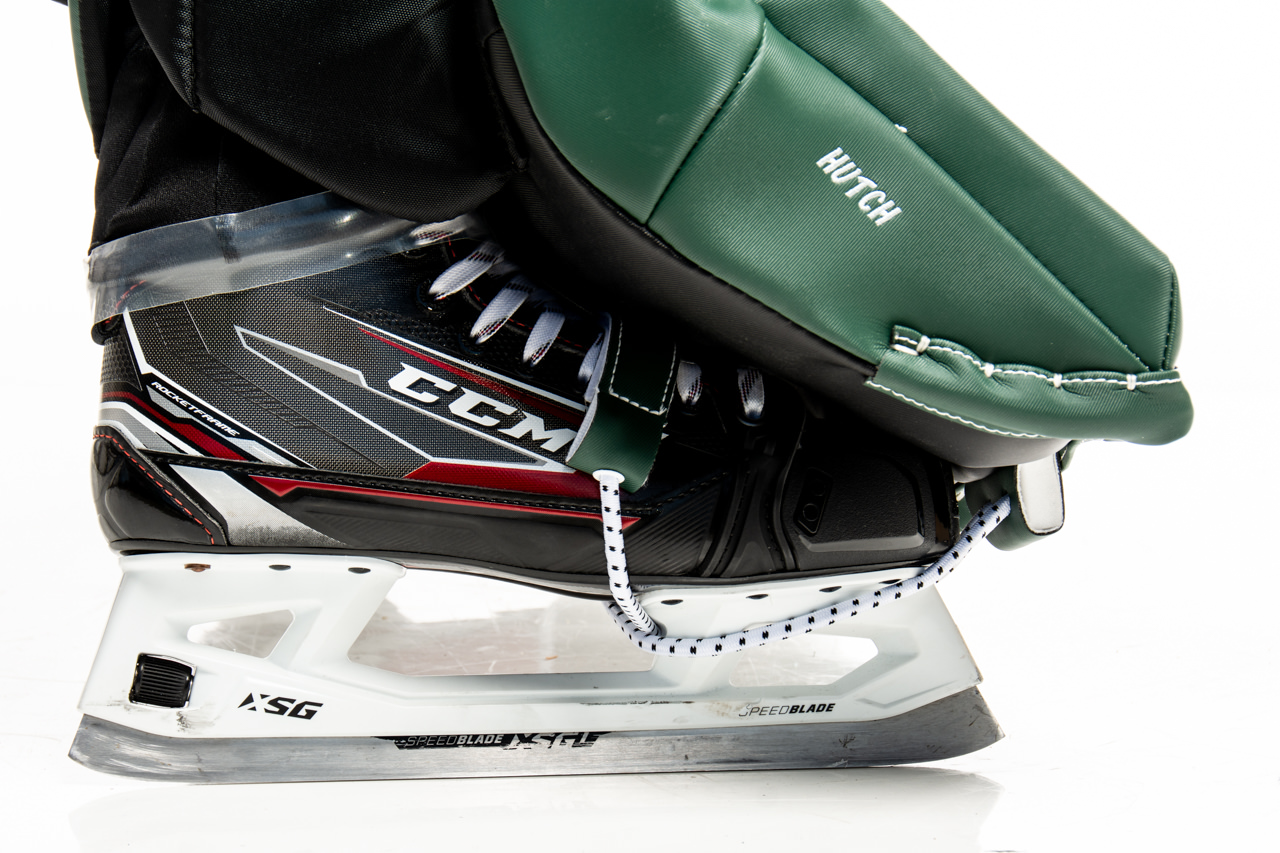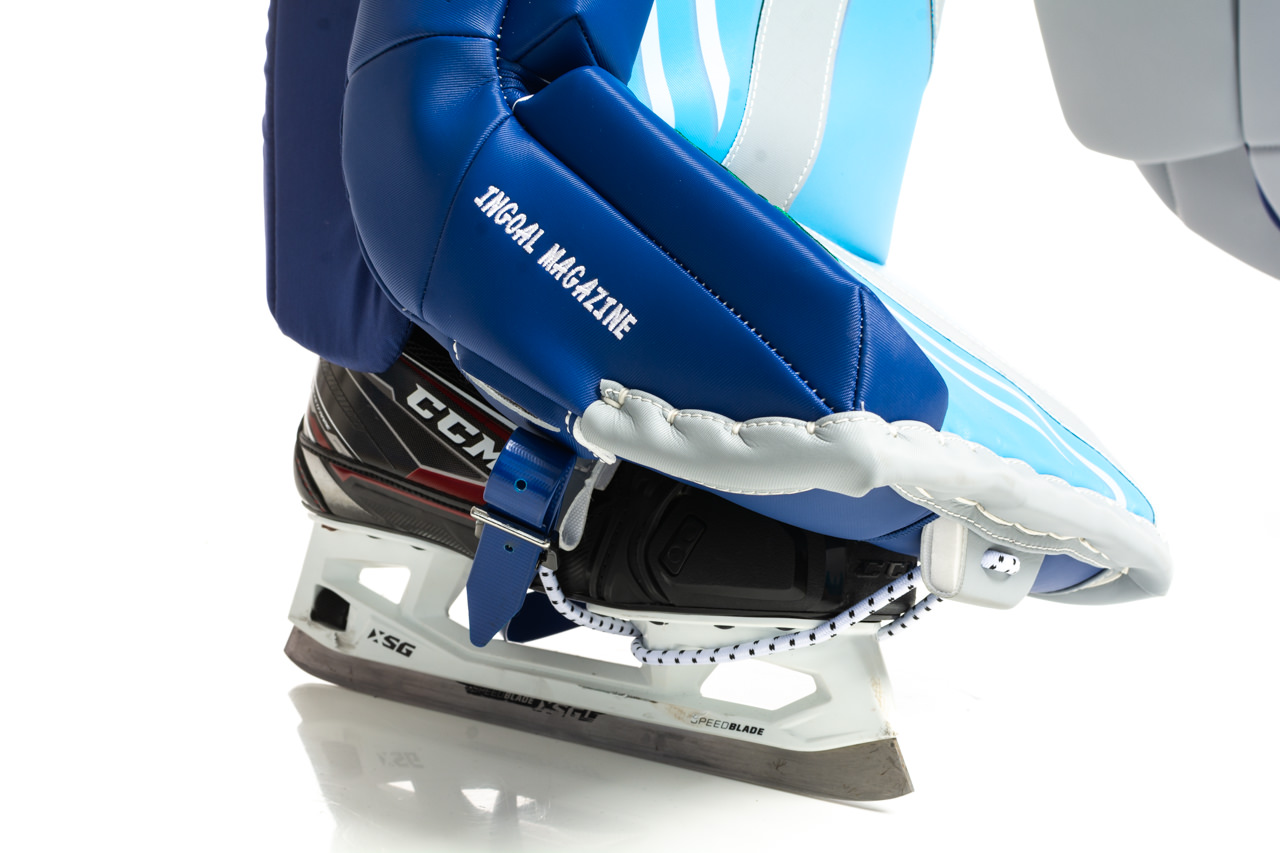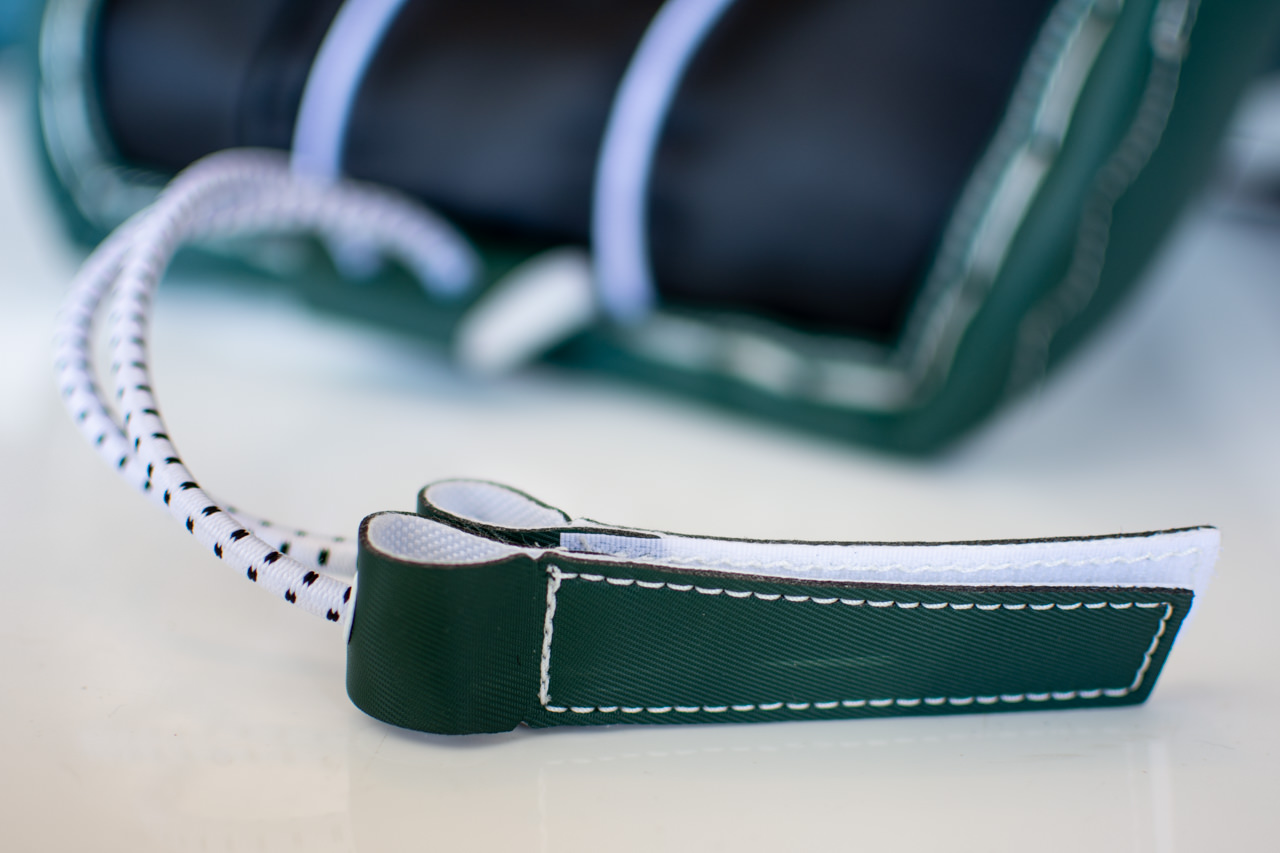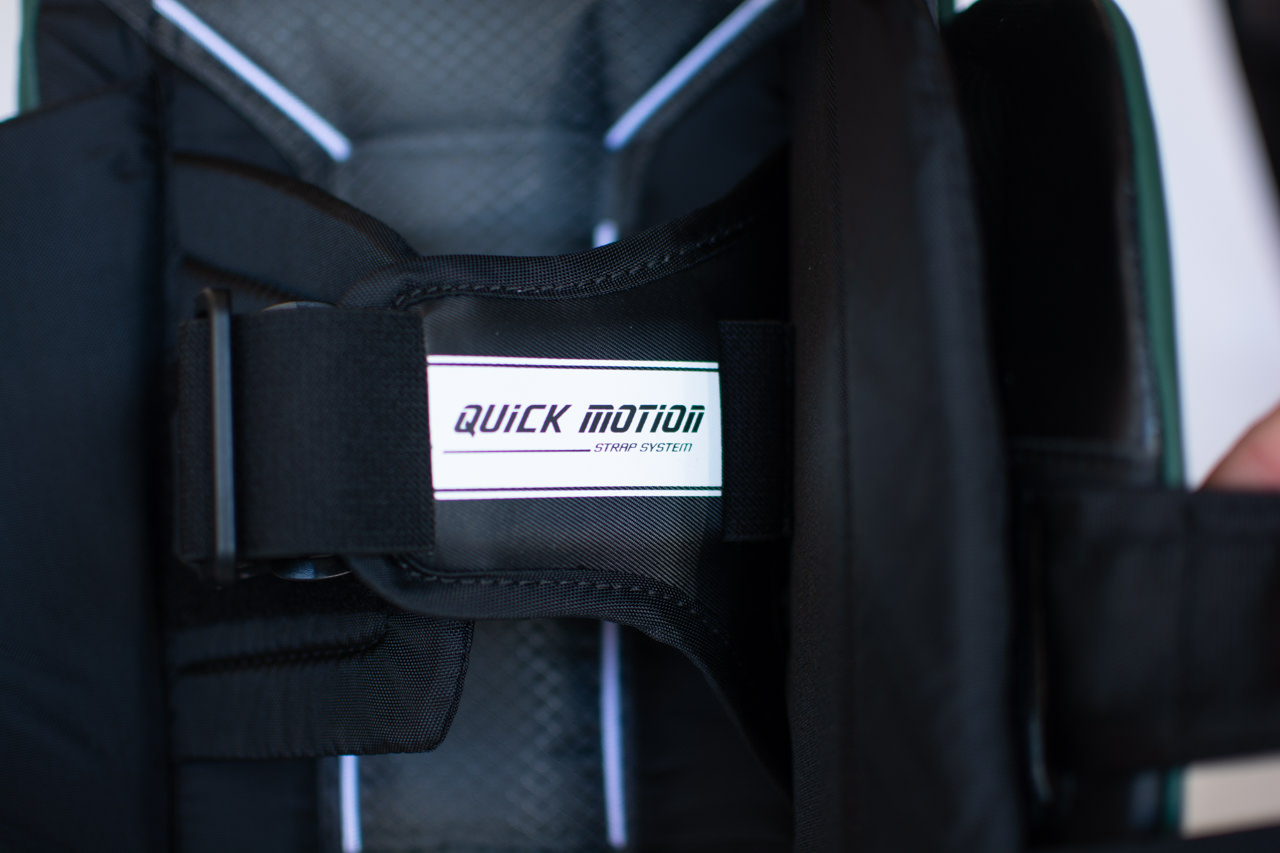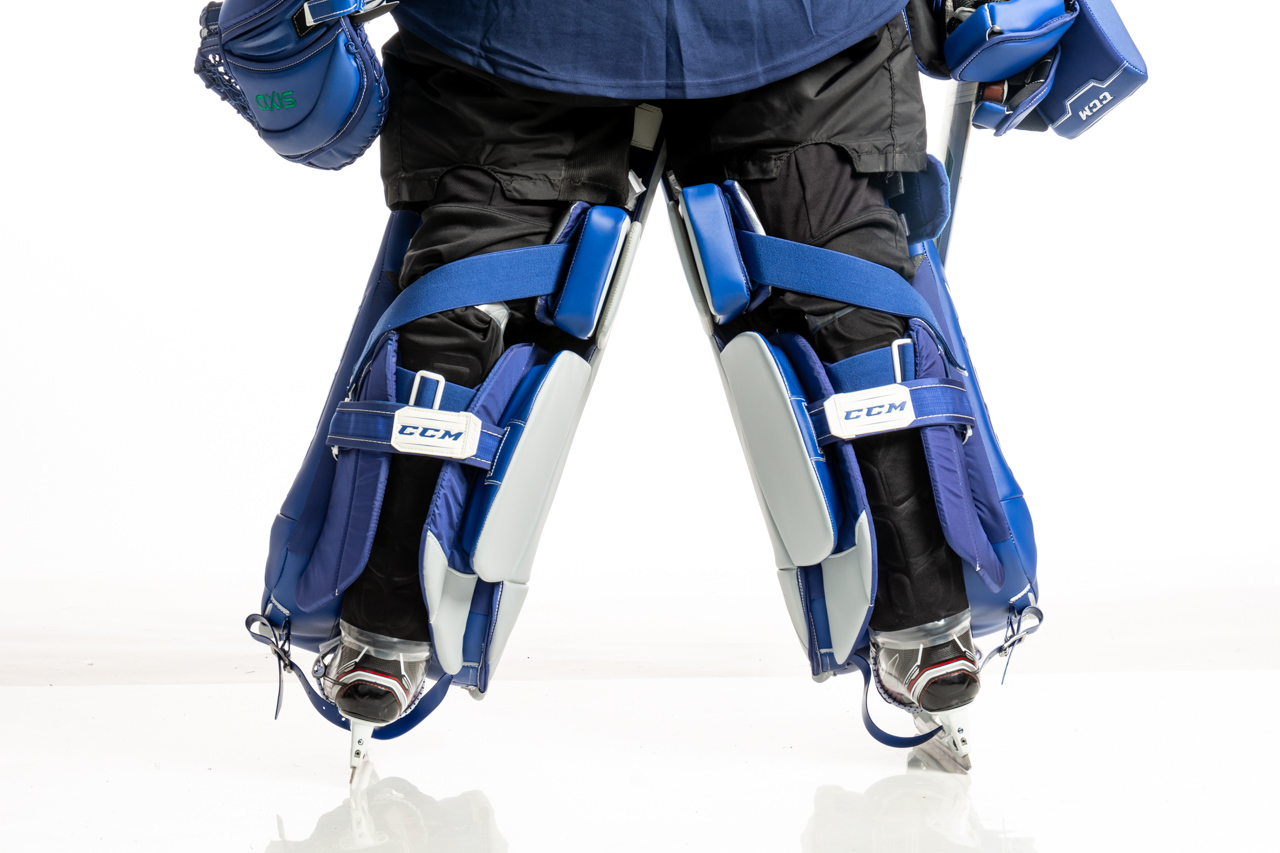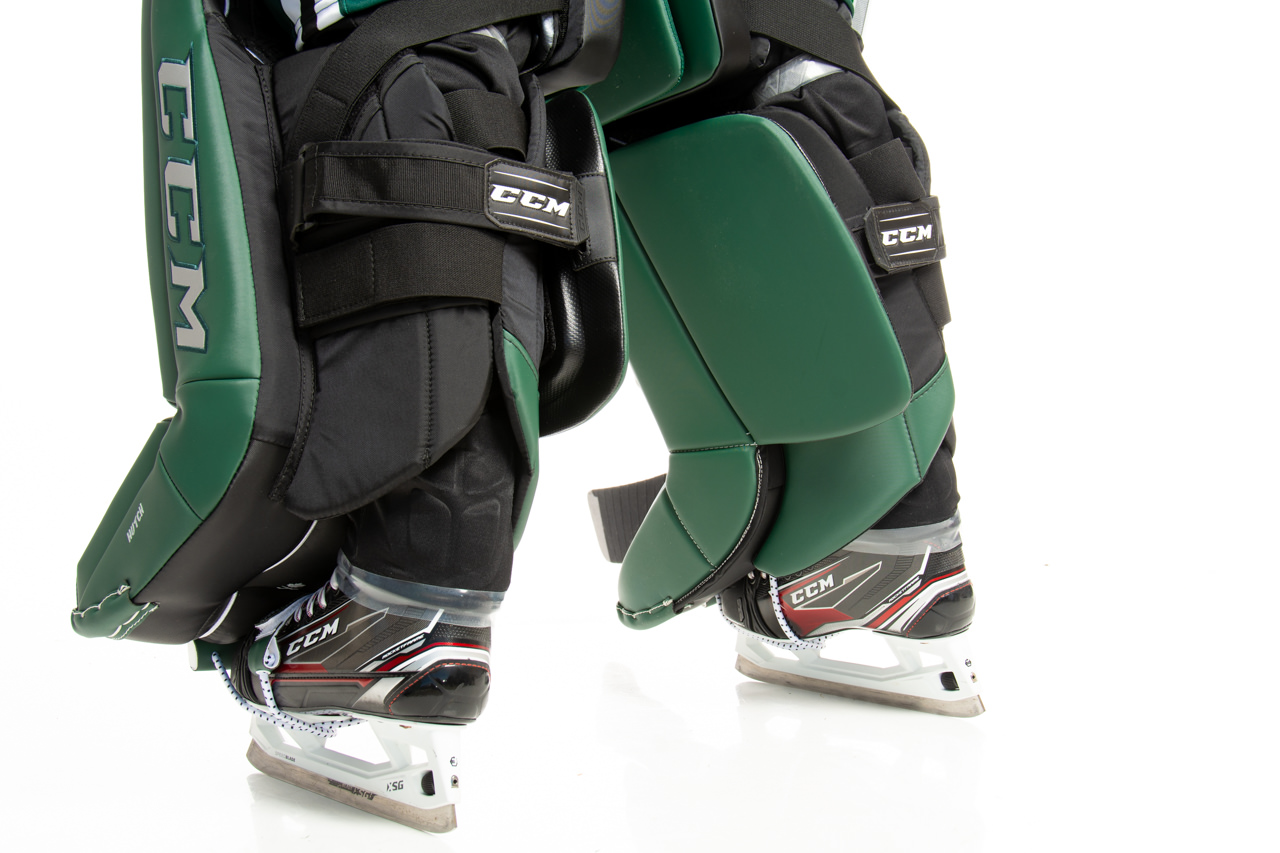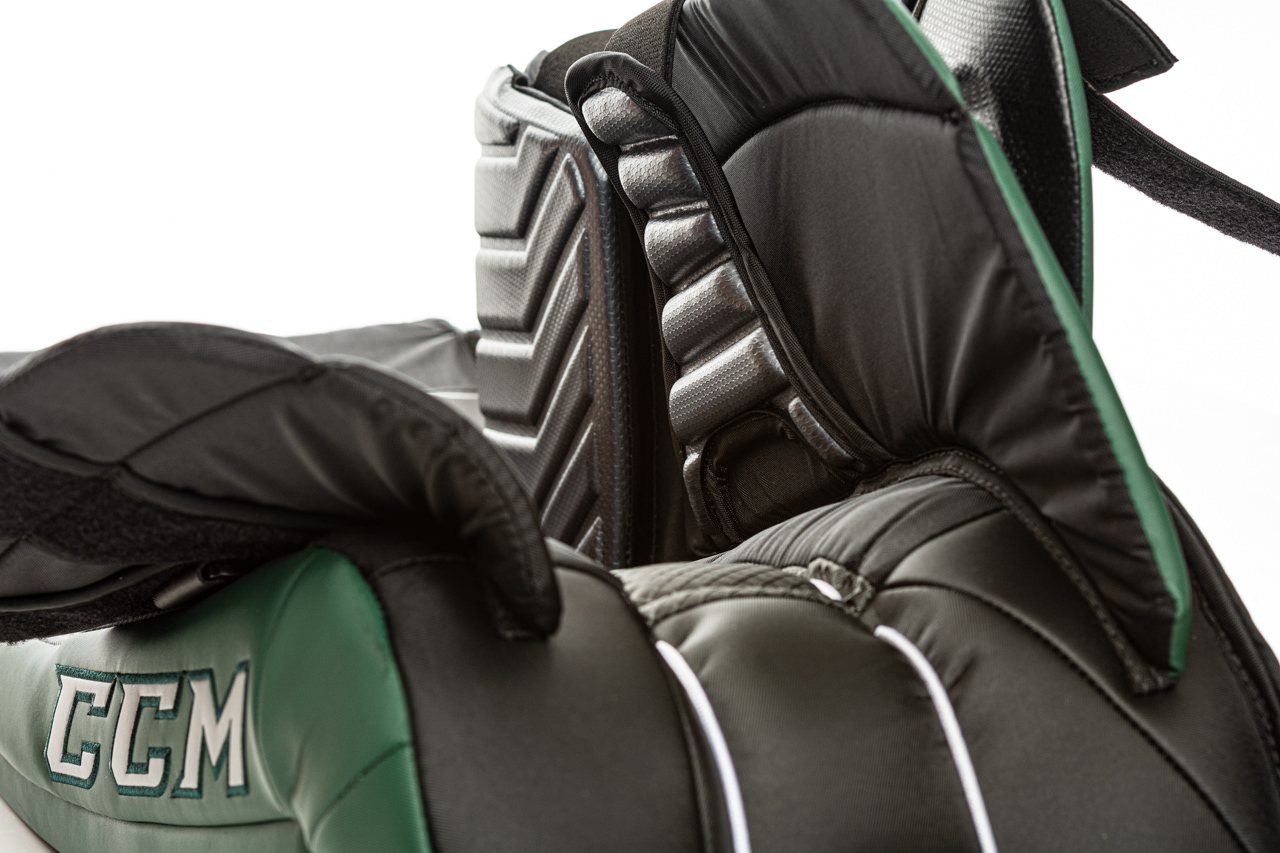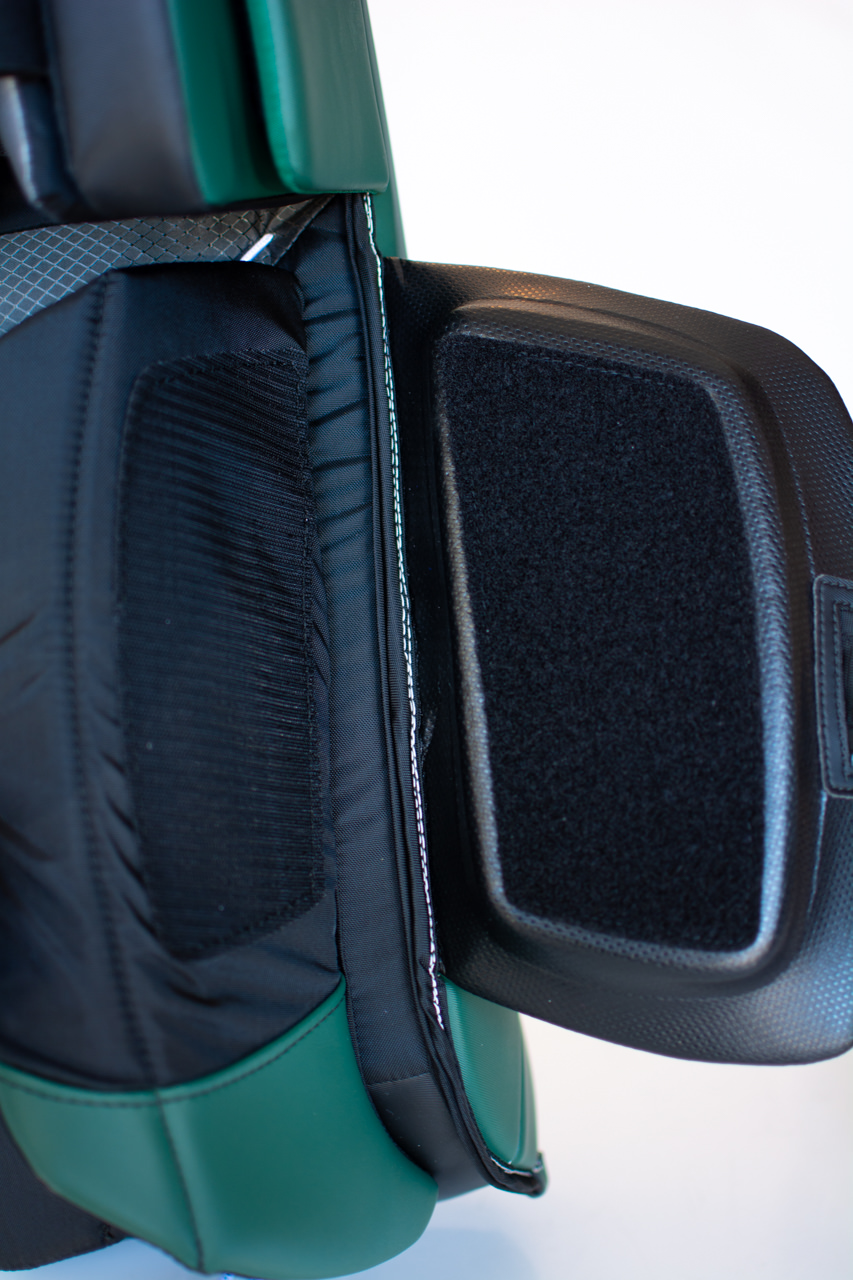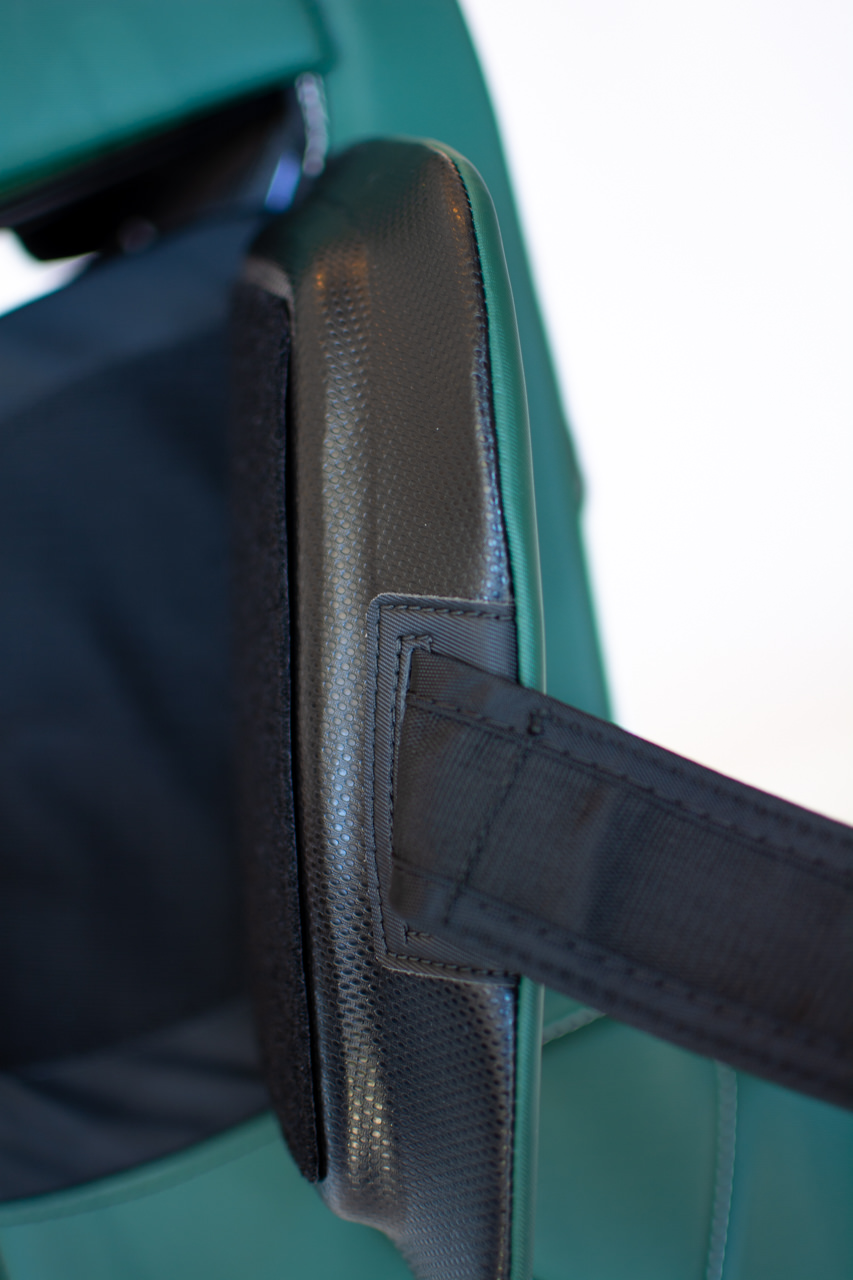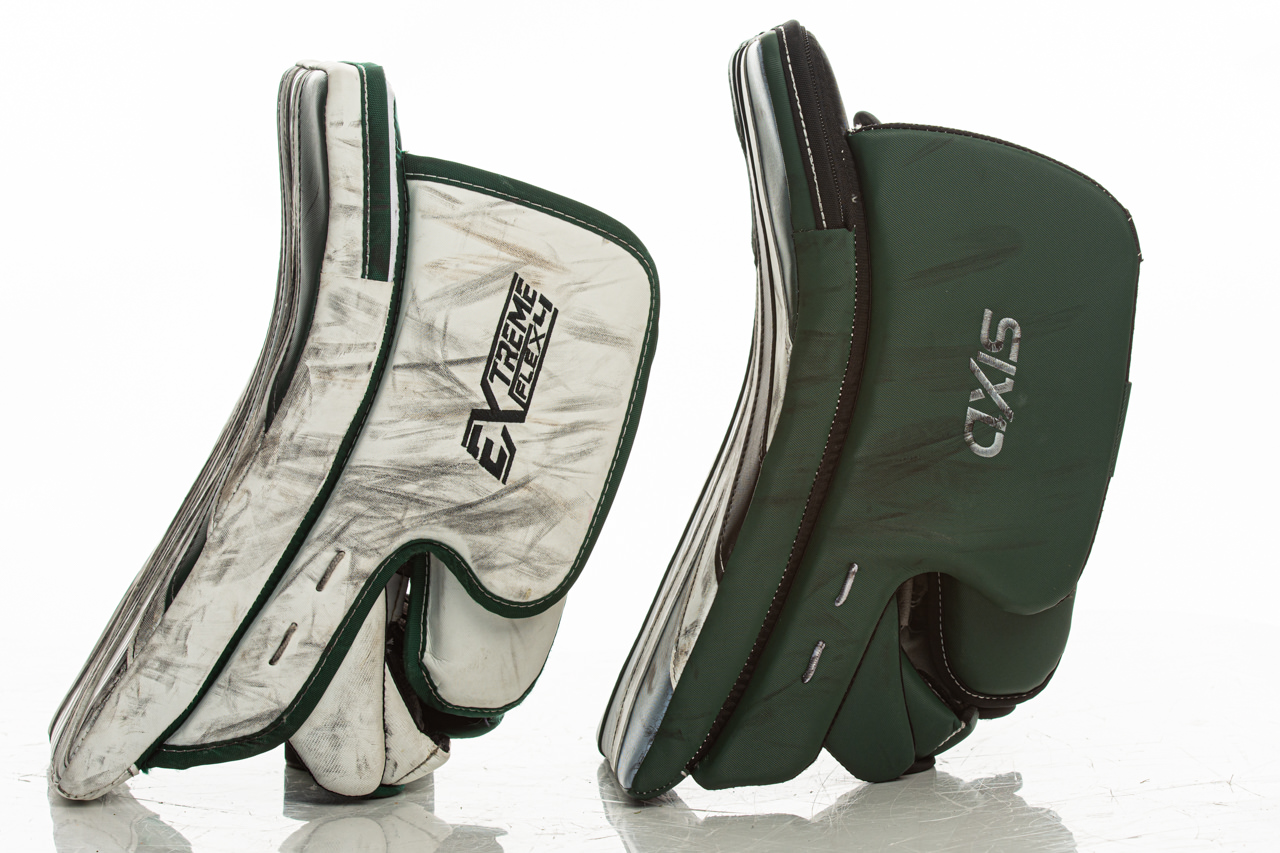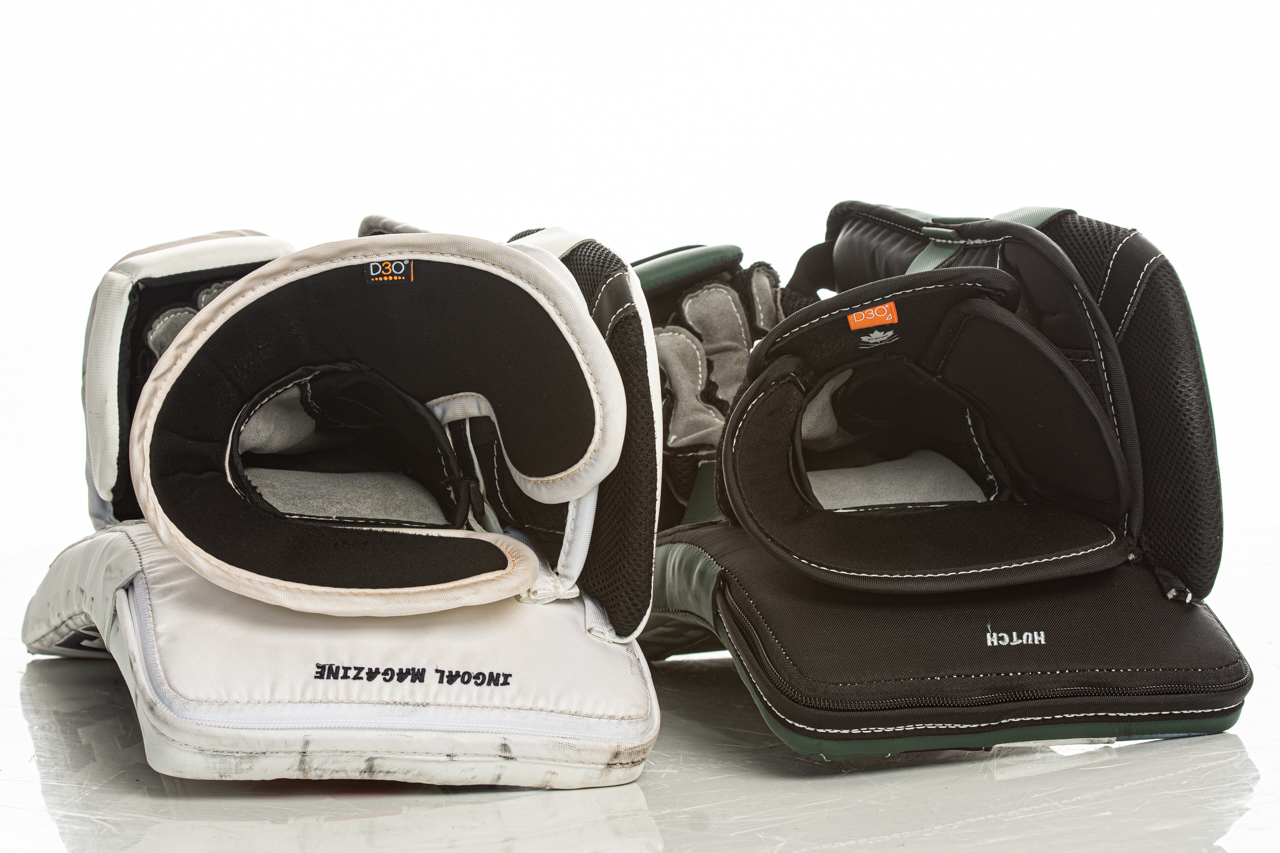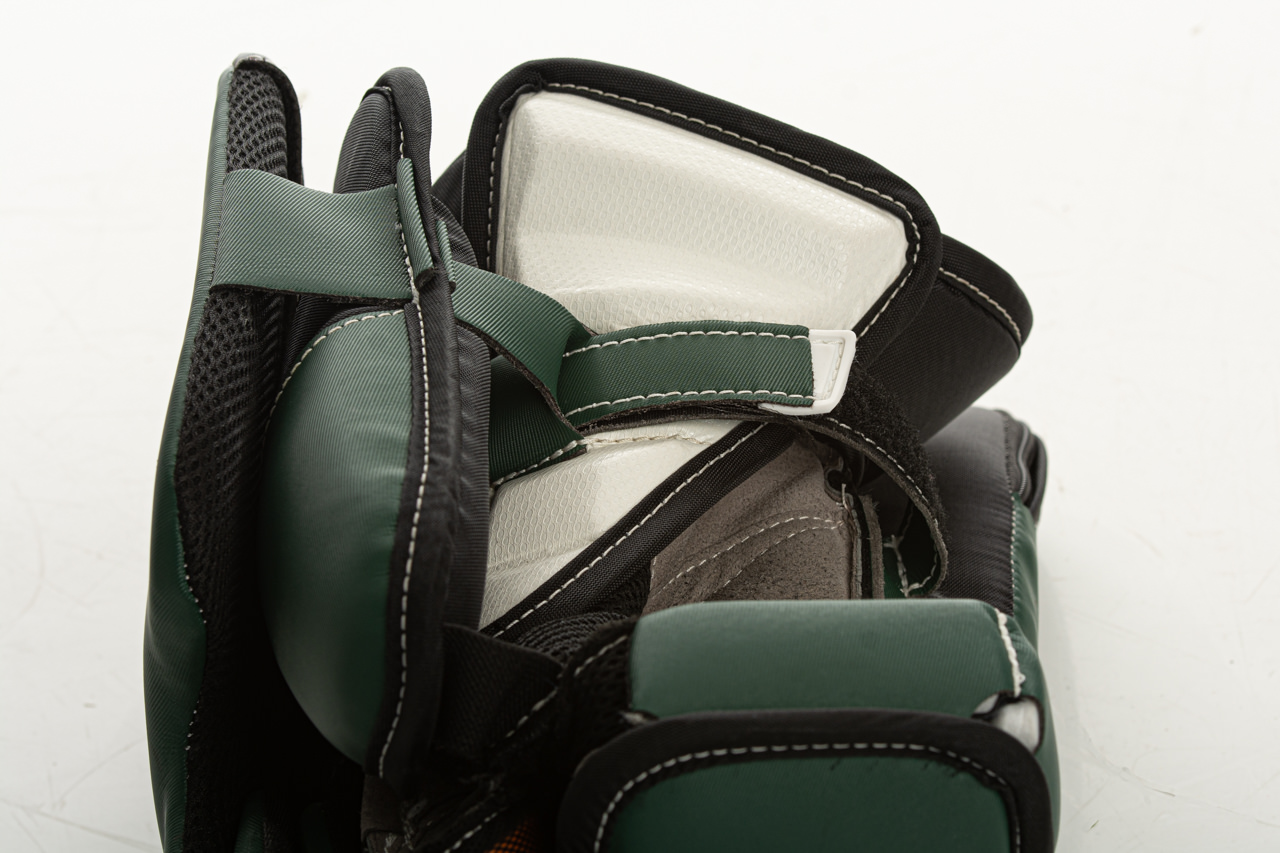Welcome. This article is unlocked for everyone to enjoy. We hope you’ll consider joining InGoal Premium with lots of new Members-only content every week – join today! Already a member? Login here
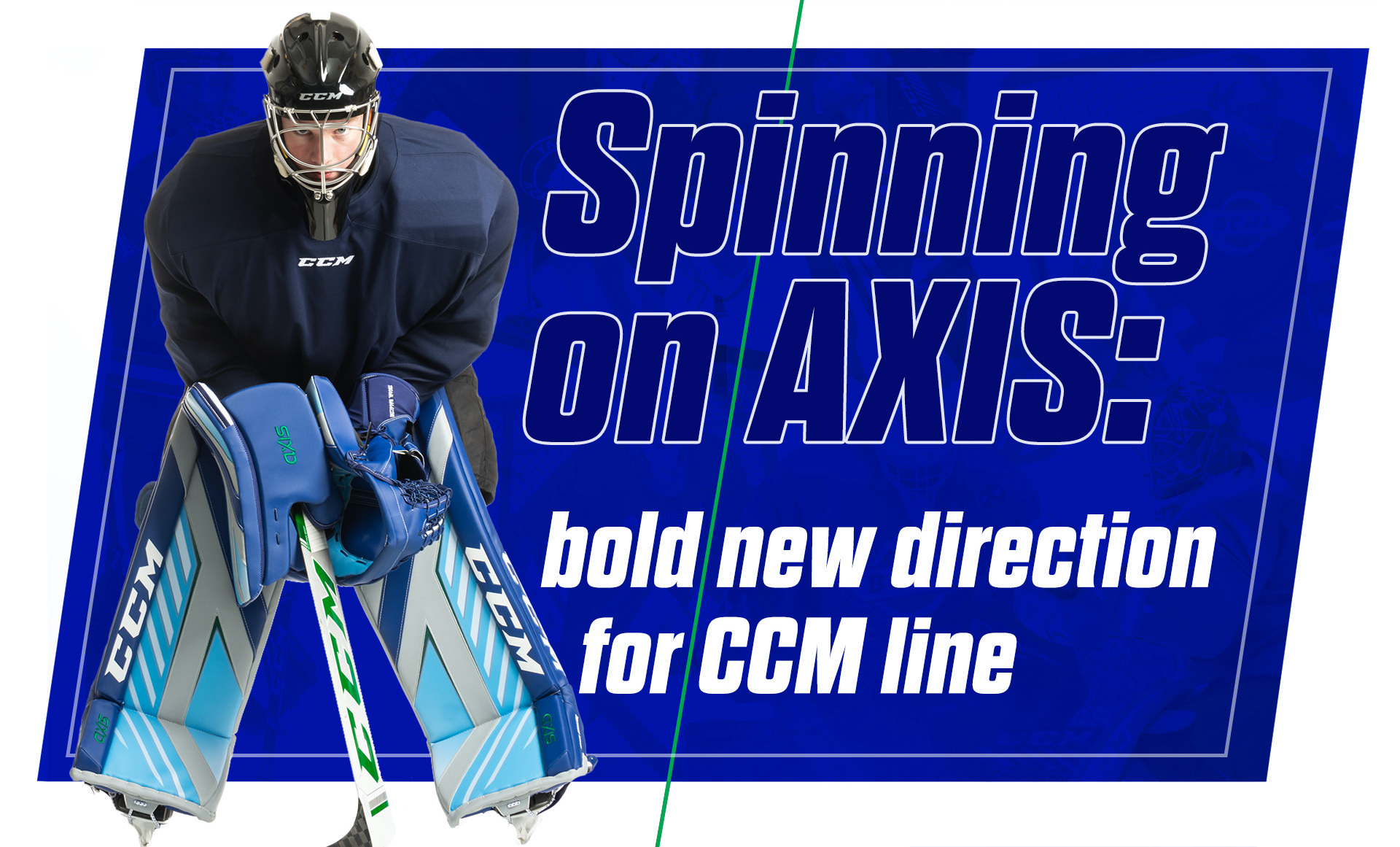
It’s fitting CCM gave its new goalie gear line a new name because AXIS represents a significant departure from the Premier line that preceded it, and given the long list of big NHL names that wore it over the previous 16 years, taking that step has to be considered a bold move.
The name itself makes perfect sense – let’s face it, the game revolves around us goalies. We are the “AXIS” around which everything orbits. A bold statement perhaps, but the goalie union knows it’s true. And when it comes to taking bold new steps, the AXIS line also delivers.
From a bold new look that features CCM’s first binding-less faced pad as well as UV Printing and a HEXA Print on multiple zones; to a notably flatter, more flexible boot break; to getting rid of the rounded inner edge that for so long was a defining characteristic of the Premier line, there is no question that AXIS is a bold change of direction for the CCM goalie team in Montreal.
The first thing that jumps out once you have a set in your hands, however, is the weight.
Our InGoal Magazine test set was 34+2 and weighed in at just 4 pounds, 8 ounces (without the removable bootstrap). That’s 3 ounces lighter than a test pad from our Premier 2 set, and those were a 33+1 pad, so 2 inches shorter, and represented a one pound reduction from the Premier line before that. Given all that, it probably shouldn’t come as a surprise the light weight and thinner profile was the first comment from every goalie that’s seen our test sets in person.
For all the big changes, however, AXIS stays true to a lot of the performance roots of its Premier predecessor: from the familiar flat face and firm, pre-curved profile, to purposely powerful rebounds that started with Reebok XLT in 2014 and are enhanced even further in AXIS.
Like the Premier pad before it, the new AXIS also maintains some distinctions from its CCM Extreme-Flex counterpart, but some of the changes in flex and function found in the AXIS pad are reminiscent of elements that make the E-Flex line a best seller from minor hockey right up to the NHL, most notably in the way it allows goalies to load up powerful movements. Add in the mobility benefits of Speed Skin — and an NHL prospect who tested our set noted how much better the pads slid after trying it for the first time — and AXIS has all the makings of line that will have a lot of goaltenders pivoting to give it a try, so let’s dig into some more specifics.
Despite being off the ice for the better part of three months due to the ongoing Coronavirus pandemic, InGoal has actually been able to quickly gather feedback from a number of goalies ranging from minor hockey, to Western Hockey League-bound, current BCHL and all the way up to Dylan Ferguson, the above-mentioned NHL prospect. We also had a head start on everyone else because we first saw the new AXIS line during a trip to Montreal way back in the spring of 2019 — and you’ll find some of the research-and-development work CCM shared with us that trip sprinkled throughout this review — and we had a demo set on the ice as far back as February.
So, while this review won’t quite have the same depth of insights we prefer in terms of 10-plus test goalies with a wide range of personal preferences and playing styles trying it over the course of months, the diversity of opinions allows us to offer feedback that should help you get a better feel for how AXIS feels and fits – and most importantly how it fits your game.
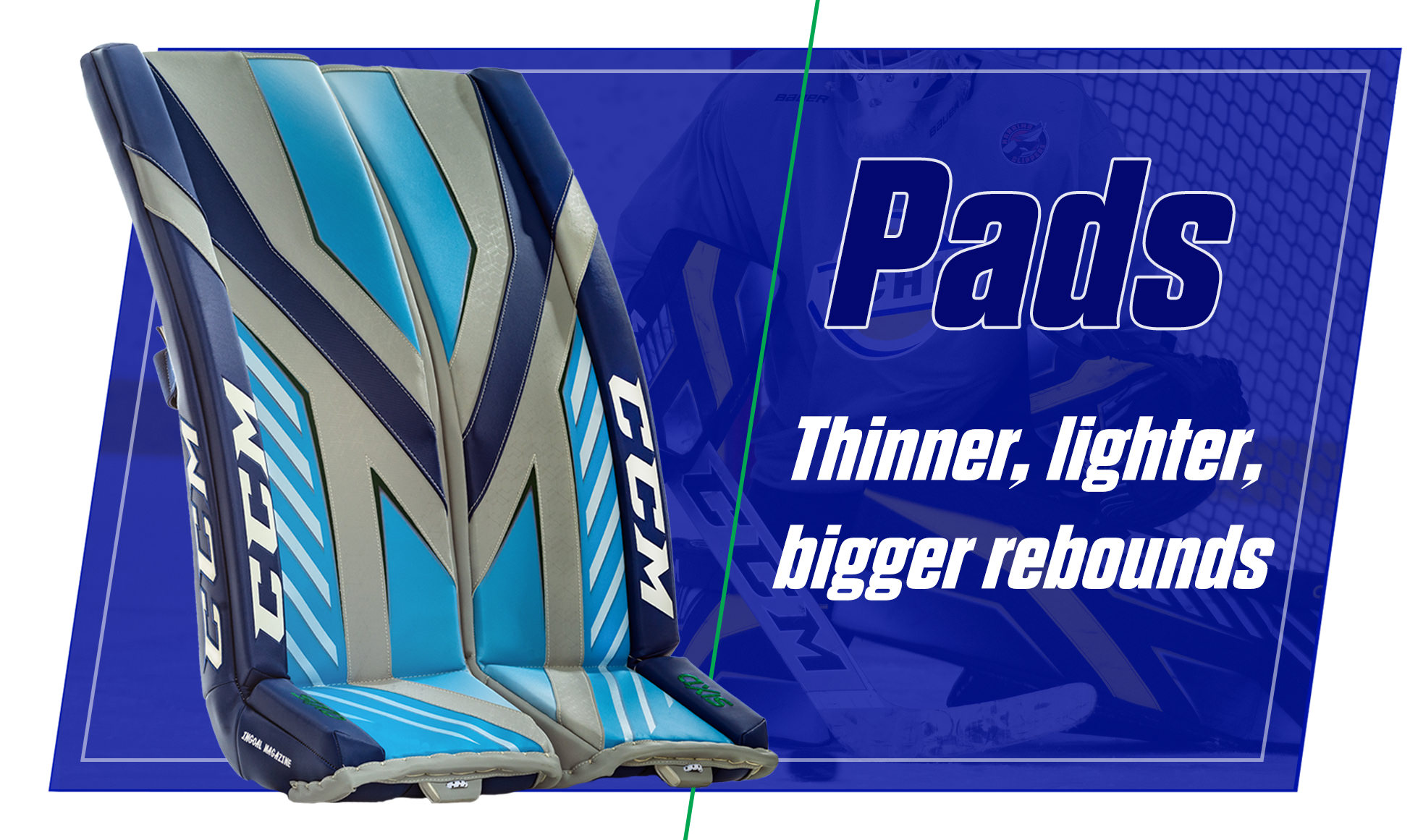
InGoal Radio Podcast presented by The Hockey Shop Source for Sports on the AXIS Pads
We looked at the AXIS pads on the InGoal Radio Podcast presented by The Hockey Shop Source for Sports Episode 85 with feature guest Evgeni Nabokov. Use the link above to hear just the gear segment or you can listen to the full episode here.
FIT, FLEX AND L1TEXCORE TECHNOLOGY
With the exception of perhaps the new graphics, the biggest change in the new AXIS pad is the undoubtedly the new L1TEXCORE, an upgraded injection-molded core that creates the notably thinner profile and lighter pad. They’ve done so without sacrificing the pre-curved profile and stiffer flex up the face of the pad that goalies have come to associate with the Premier line, but they did significantly change the profile and flex of that core at the boot break.
The way the pad sits up on the skate is unique compared to both E-Flex, with its deeper channel, and Premier, with its steeper break angle. Combined with the added flex of that boot break and the bungee toe tie, it helps create a more responsive connection, allowing for a better range of motion our early test goalies liked in terms of loading both a push or into a post in reverse-VH.
If the way the AXIS pad fits and feels at the bottom is completely different — a 180-degree spin on its axis, if you’ll pardon the pun — the top will at least feel familiar to Premier fans. From the shin up, this is a stiffer pad, with one internal break at the knee and none on the outer roll. But there is some torsional flex across the face of the pad above the knee, so it’s not like wearing a board on your leg, and the pre-curved shape is amplified by the notably thinner profile made all the more attractive — and lighter — by eliminating the binding in favor of reverse stitching.
Speaking of looking nicer, another subtle change is letting goalies choose the material and color for the outside edge of the pad — either the stock Speed Skin, emboss, or solid Clarino — rather than using nylon in this section like they have in the past. Combined with the reverse stitching, it further streamlines the look and feel, creating a seamless looking edge with an outer roll that has also been modified on the new AXIS pad. This new outer roll has been trimmed to create more of a wedge rather than the traditional rectangle shape, helping reduce the weight by shedding material while still maintaining maximum width and coverage at the top and a wedge shape that could help knock down pucks in tight and prevent skip over goals.
Turning to the inside edge, the complete redesign of the core continues.
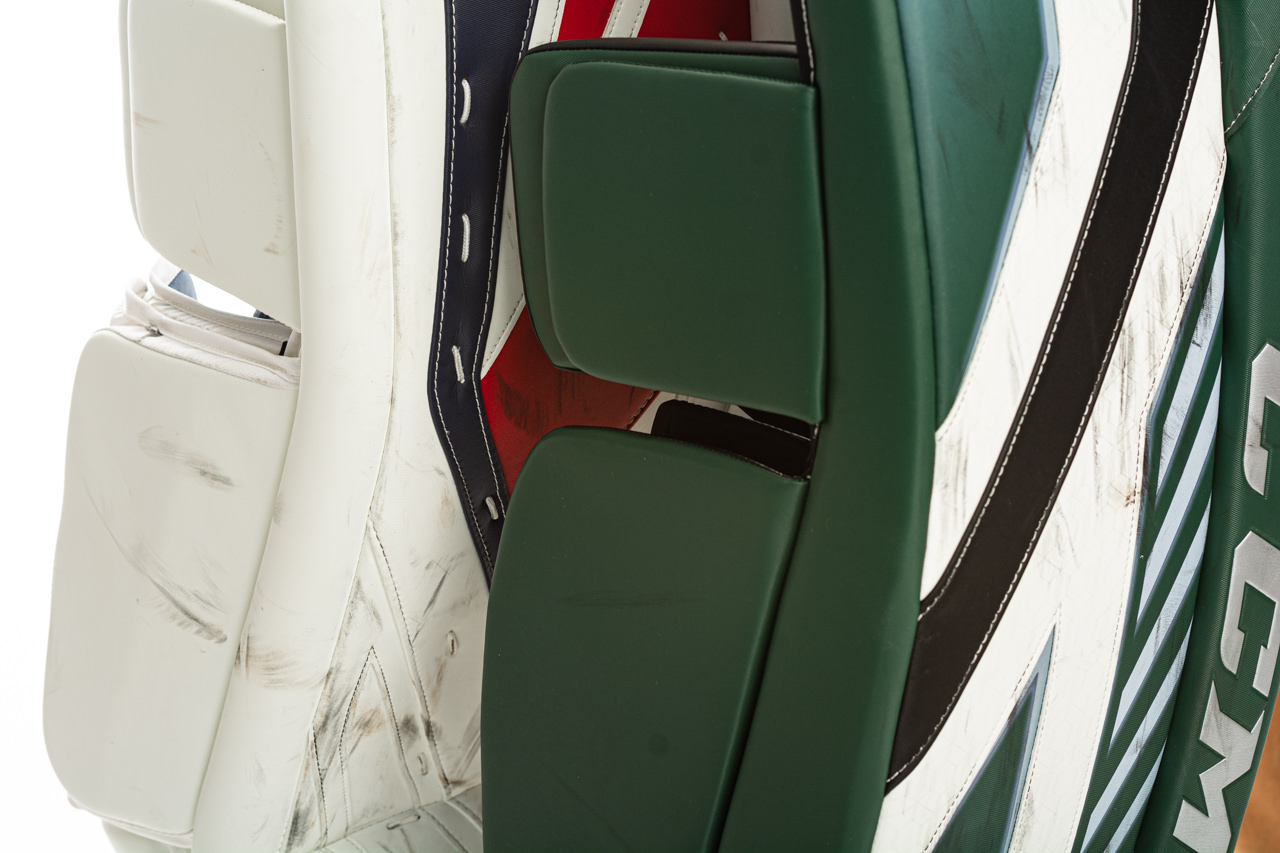
which improved sliding, seal, and surprisingly, even rebound control.
“The difference was noticeable the first time I tried them,” said Ferguson, who had been wearing a set of E-Flex 4 without Speed Skin during his recently completed his first pro season in the Vegas Golden Knights organization.

The AXIS might be CCM’s latest but that didn’t stop Vegas prospect Dylan Ferguson from going old school for a nice glove save in the first of several skates in the InGoal test set. A longtime E-Flex wearer, this was Ferguson’s first time in Speed Skin which made the already dynamic goaltender that much faster on the ice.
Flipping the AXIS pad over to look at the backside, we’ve already mentioned the bungee-and-Velcro toe tie system that debuted on the E-Flex 4 line continues here and the boot has a shallower channel. The bootstrap is removable on stock pads, and per previous lines can be ordered without, or with it angled either under the skate or back behind the heel. Moving up the back of the pad, the leg channel is wider and shallower than the E-Flex line, keeping with the “looser” fit preferences of the Premier line. But the addition of the adjustable “Quick Motion” elastic strapping around the calf makes it possible to maintain more of that connected feeling some goalies like. The AXIS Quick Motion strap has been improved from the Premier 2, which came with different length elastics that have been replaced by an adjustable strap, and now attach directly around the calf on both sides (there was an extra inner calf wrap between the Quick Motion strap on the Premier 2 and E-Flex 4 that has been removed here), with a rich-looking, molded foam ribbing on the inner strap padding reminiscent of the 3D grip knee.
Moving up the back of the pad, the leg channel is wider that E-Flex line, keeping with the “looser” fit preferences of the Premier line. But the addition of the adjustable “Quick Motion” elastic strapping around the calf makes it possible to maintain more of that connected feeling that some goalies might like. The AXIS Quick Motion strap has been improved from the Premier 2, which came with different length elastics that have been replaced by an adjustable strap, and it now attaches directly around the calf on both sides (there was an inner calf wrap between the Quick Motion strap on the Premier 2 and E-Flex 4 that has been removed here), with a rich-looking, molded foam ribbing on the inner strap padding reminiscent of the 3D grip knee.
A closer look at the soft foam wedge
that sits under the calf on the
inner edge of the pad.
Continuing to move up the pad, the AXIS pad uses the above-mentioned 3D Grip knee cradle, an injection-molded EPP foam layer on the top of the knee that was designed by the CCM research-and-development department to both keep the knee in place better (because goalies know nothing tear a groin faster than slipping off a knee stack) and also provide additional cushion when dropping into a butterfly, a force they’ve measured at three times a goaltender’s body weight (so a 180-pound goalie generates 540 pounds of force with every drop). It was adopted by a lot of goalies in the NHL since it debuted, including Pekka Rinne, who also liked that it didn’t collect moisture like previous materials, and get heavier during a game.
“Way better,” Rinne told us two seasons ago. “It’s kind of sticky and keeps your knee in place.”
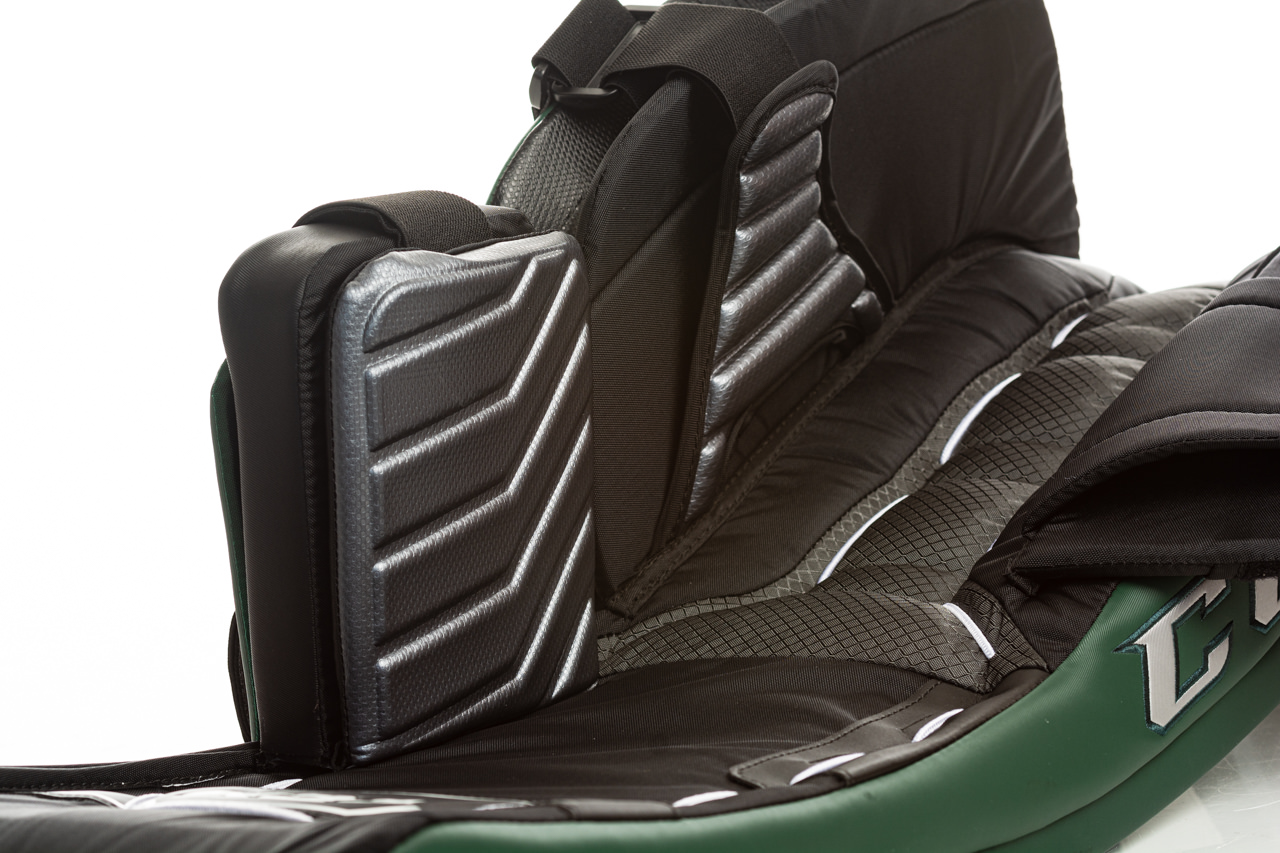
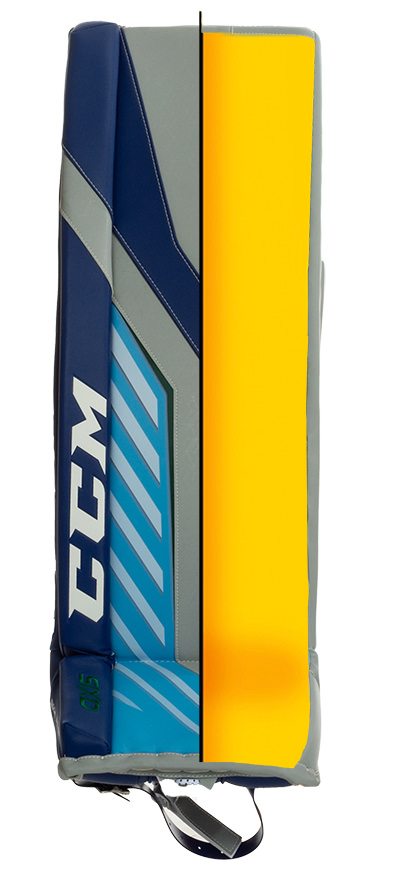
MAX REBOUND+
That pretty much wraps up the outside of the AXIS pad features but there’s still the inside to discuss, and when it comes to producing those long, hard rebounds most goalies prefer these days because it buys them time to recover, there’s an important added layer inside.
“Rebounds for sure came off the pads a lot quicker; it felt like I knew where they were going before it even hit the pad.”
Sitting between the core and the outer materials is a layer of yellow foam that CCM calls “rebound positive.” In other words, it is designed to produce more bounce. We introduced a version of this foam to the InGoal audience during a review of the original CCM Extreme Flex Shield chest protector, which used an impact dampening foam in areas you wanted helping absorbing a rebound, and the “rebound positive” yellow foam for spots you wanted the puck to ricochet off hard. CCM is using a layer of this yellow foam to make sure rebounds do the same, but they’ve actually doubled the thickness from what was used in Premier 2, and they spent a lot of time in their puck-shooting laboratory in Montreal to get that combination right:
“Rebounds for sure came off the pads a lot quicker,” said Ferguson, who obviously would have noticed an even bigger difference coming from the E-Flex 4 line, which CCM labels a “rebound neutral” pad. “It felt like I knew where they were going before the puck even hit the pad.”
That consistency is another improvement in the AXIS rebound compared to the Premier line because CCM finally got rid of that rounded radius roll that makes contact with the ice.
InGoal did some experimental testing of its own with high-speed video over the past year and while the results proved that the Premier 2 pad did indeed create stronger rebounds than the E-Flex line, as expected, that was not the case for pucks shot along the ice. With the Premier pad, pucks along the ice were frequently absorbed by the radius roll rather than hitting the face of the pad, and rebounded considerably slower than even the E-Flex pad. That inconsistency should end with the flat, high-density inside edge on AXIS, and early feedback concurs.
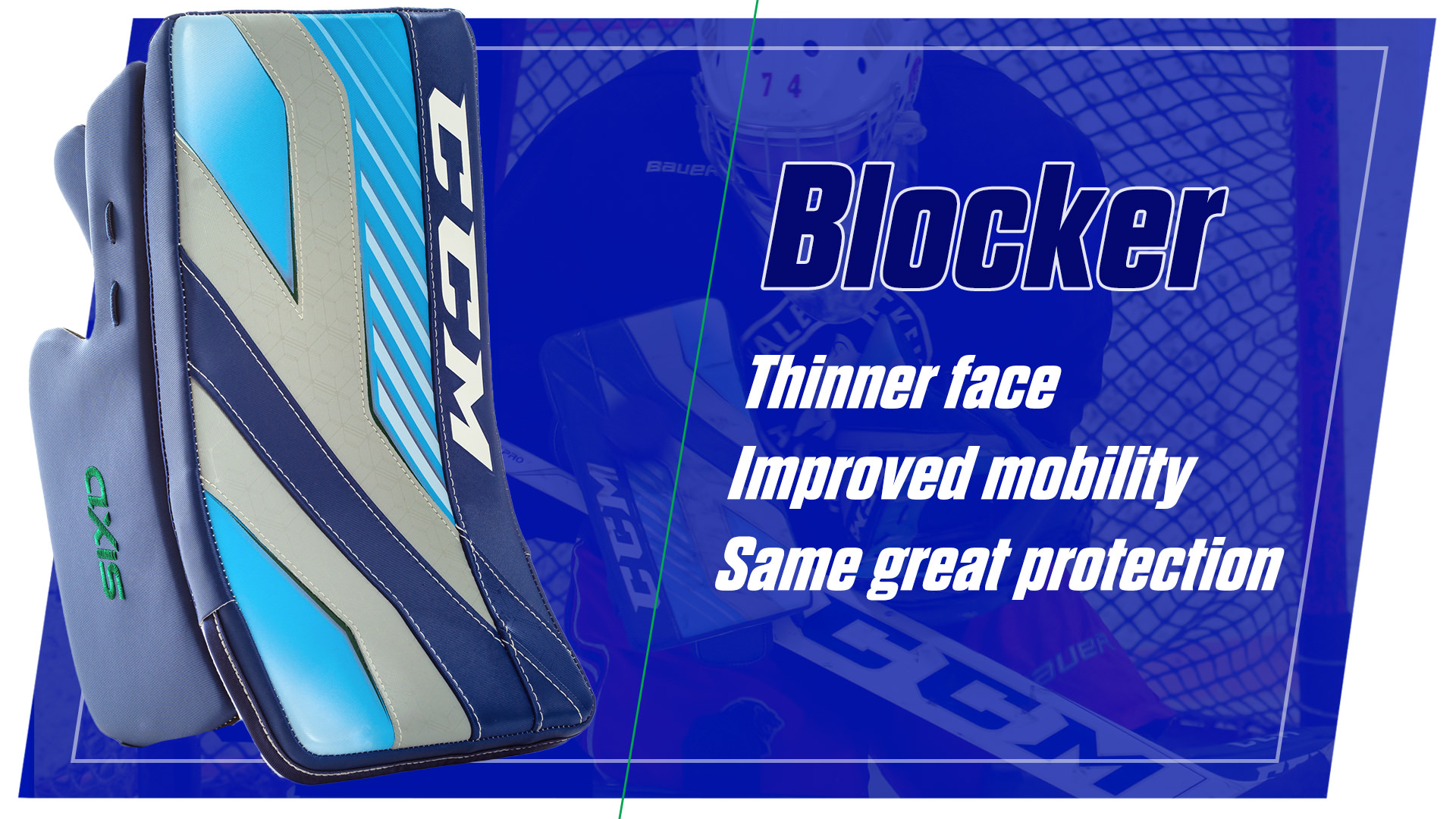
Unchanged for years as the NHL standard for protection, the CCM blocker actually has a couple of subtle tweaks in the new AXIS model. The board has been thinned out to reduce the weight (it’s 1.7 oz lighter than E-Flex), and there is a new three-piece cuff that includes a molded foam component.
The AXIS blocker continues to use a layer of impact-absorbing D3O foam that wraps around the tip of the index finger for increased protection when pucks deflect or roll up the paddle. It comes stock with curved finger protection, though straight is available in custom, and the palm is available in CCM’s SureGrip material or multi-layered Nash in either grey or beige.
(seen here in white) that can be also be ordered in color.
The new AXIS cuff features three sections, including a rich-looking padded middle section of molded foam that runs down over the base of the thumb for added protection, that are connected with elastic, which should allow it to open a bit more than the “laced-in” cuff on the E-Flex blocker. After using a nylon quick release wrist strap on E-Flex 4, the AXIS wrist strap is a Speed Skin-and-Velcro combination, though the stitched-in opening at the wrist hinge below the strap limits how much you can really open it by loosening the strap anyway.
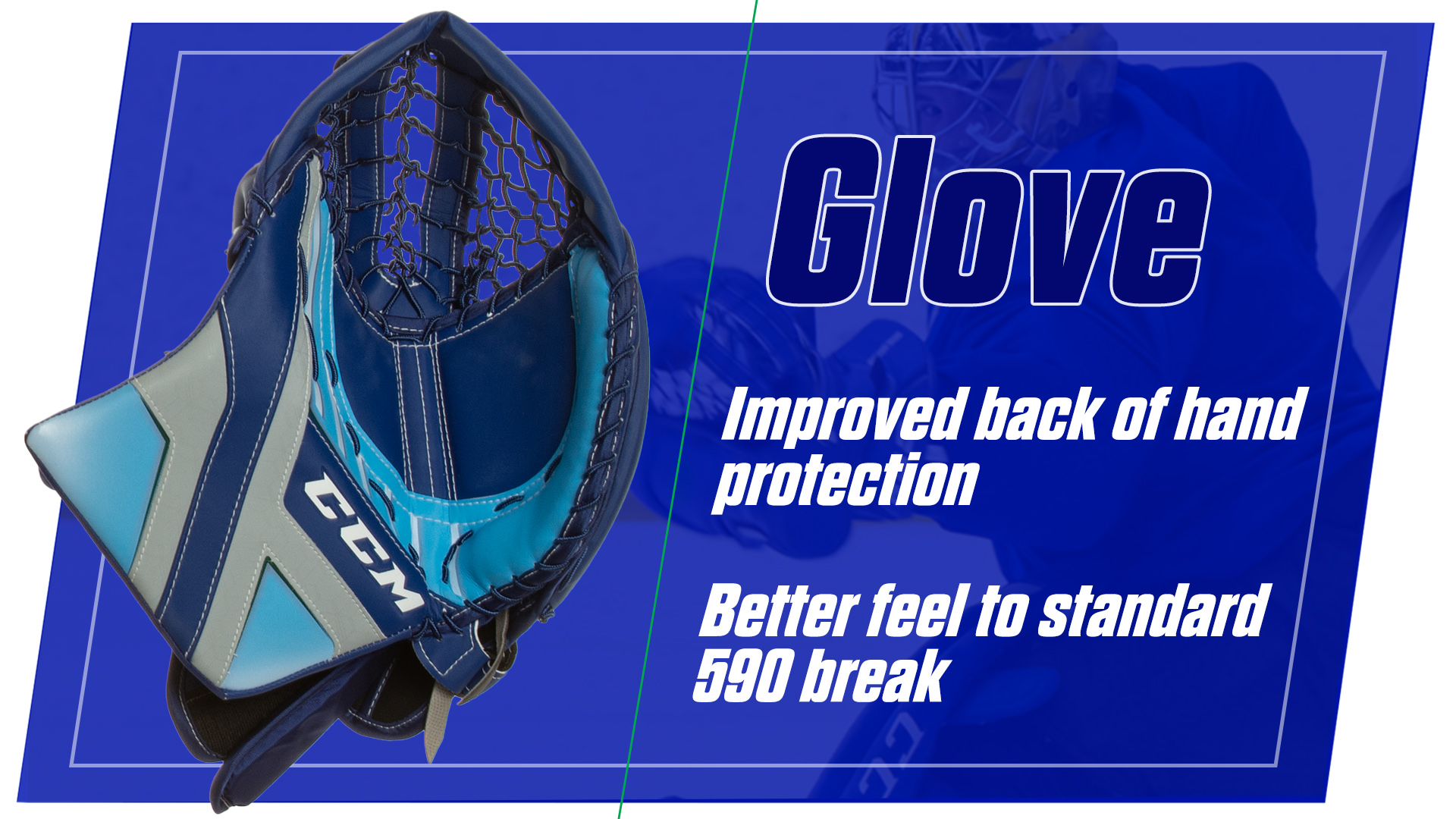
It’s hard to quantify, and obviously glove feel and preference can vary widely from one goalie to the next based on everything from hand size to how far you push it into a glove, but the consensus among a couple goalies able to put their hands in both the new AXIS 590 and our old Premium 2 590 was that it was somehow easier to get your hand deeper into the break of the new glove, providing an easier, slightly snugger feeling, full-handed closure wrapping around the break more. The break angle hasn’t actually changed —the 590 is stock on AXIS, but you can custom order it in the 580 or 600 break as well (for a full breakdown of CCM’s break angle options and how they close from our E-Flex 4 review, click here) but slight modifications to the stock double-T pocket and the back of the hand may slightly affect the feel of the closure.
Either way, it was a feeling all of our testers early testers liked.
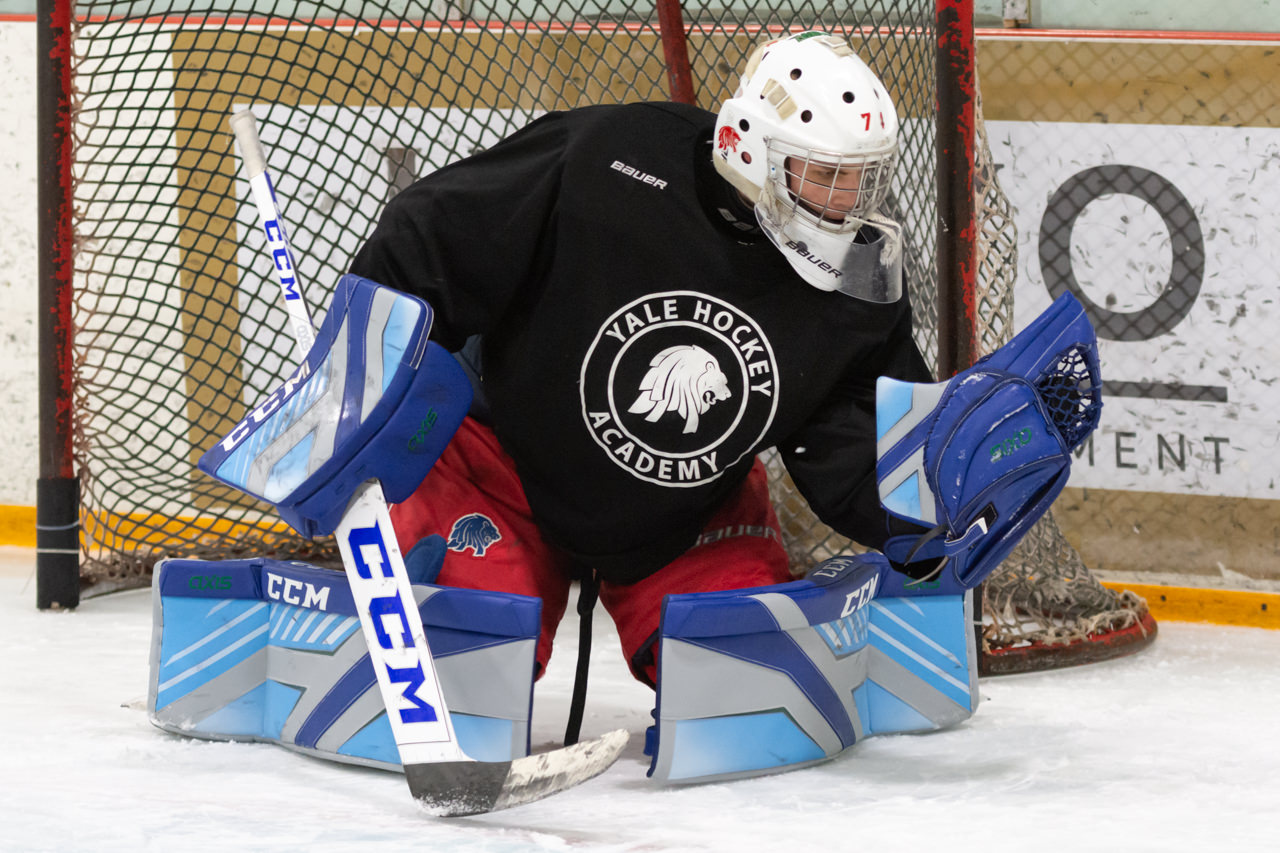
Many key features have been carried over from E-Flex 4 and Premier 2 lines, including the use of impact-absorbing D3O foams in the palm of the glove for increased protection and insulation from puck impact (by absorbing the impact, not kicking it away like a harder material might), and the use of Speed Skin material on stock gloves. That includes the improved adjustability in the strapping on the back of the hand inside the glove that debuted with Premier 2, and a quick-release wrist strap tab on the outside of the glove that debuted on EFlex-4 and makes life a lot easier for goalies that like to cinch it up tight without having to open up the wrist.
CCM will also continue to offer three levels of protection at custom: a “Game Ready Palm” with 5/16-inch layer of felt; the “Pro Palm” with a 1/2-inch layer of felt; and the “Practice Palm” with two 5/16-inch layers. But since adding the three-millimeter layer of D3O to the palm, they have seen a decrease in the use of “practice” gloves right up to the NHL. And because that thin layer of D3O in the palm won’t break down, goalies will still be protected even as the rest of the glove softens over time, enhancing the durability in a line already known for it.
Speaking of durability, CCM gloves continue to use more-expensive injection molded plastic components rather than compression molded parts that tend to lose their shape faster.
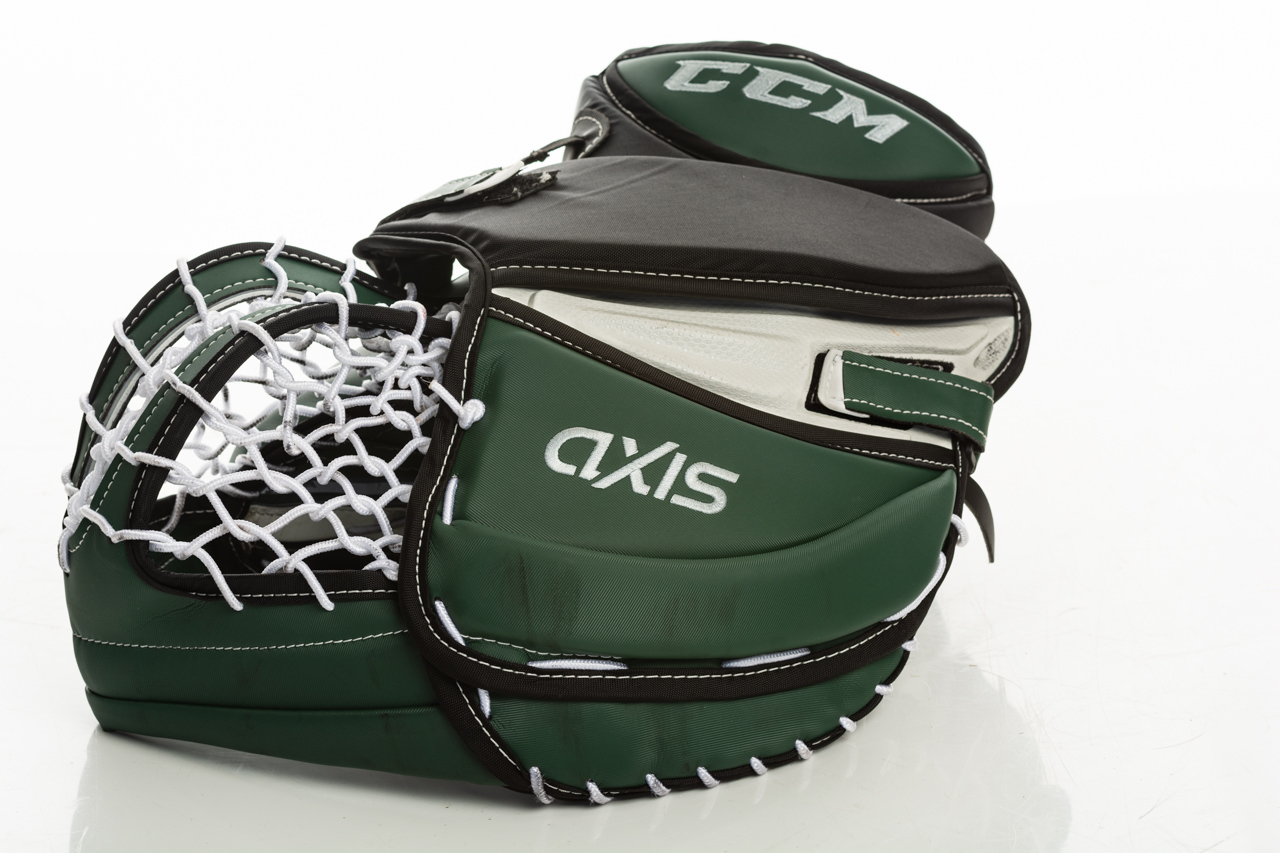
It’s hard to quantify, and obviously glove feel and preference can vary widely from one goalie to the next based on everything from hand size to how far you push it into a glove, but the consensus among a couple goalies able to put their hands in both the new AXIS 590 and our old Premium 2 590 was that it was somehow easier to get your hand deeper into the break of the new glove, providing an easier, slightly snugger feeling, full-handed closure wrapping around the break more. The break angle hasn’t actually changed —the 590 is stock on AXIS, but you can custom order it in the 580 or 600 break as well (for a full breakdown of CCM’s break angle options and how they close from our E-Flex 4 review, click here) but slight modifications to the stock double-T pocket and the back of the hand may slightly affect the feel of the closure.
Either way, it was a feeling all of our testers early testers liked.
In addition to opening wide and presenting big to shooters, the CCM Double-T pocket makes it easier to see the puck when you catch and cover it, something Carey Price has told us he likes in past interviews. Goalies can custom order the pocket with skate lace in white, black, red or royal blue, while the nylon lace is available in eight additional color options.
Many key features have been carried over from E-Flex 4 and Premier 2 lines, including the use of impact-absorbing D3O foams in the palm of the glove for increased protection and insulation from puck impact (by absorbing the impact, not kicking it away like a harder material might), and the use of Speed Skin material on stock gloves. That includes the improved adjustability in the strapping on the back of the hand inside the glove that debuted with Premier 2, and a quick-release wrist strap tab on the outside of the glove that debuted on EFlex-4 and makes life a lot easier for goalies that like to cinch it up tight without having to open up the wrist.
CCM will also continue to offer three levels of protection at custom: a “Game Ready Palm” with 5/16-inch layer of felt; the “Pro Palm” with a 1/2-inch layer of felt; and the “Practice Palm” with two 5/16-inch layers. But since adding the three-millimeter layer of D3O to the palm, they have seen a decrease in the use of “practice” gloves right up to the NHL. And because that thin layer of D3O in the palm won’t break down, goalies will still be protected even as the rest of the glove softens over time, enhancing the durability in a line already known for it.
Speaking of durability, CCM gloves continue to use more-expensive injection molded plastic components rather than compression molded parts that tend to lose their shape faster.
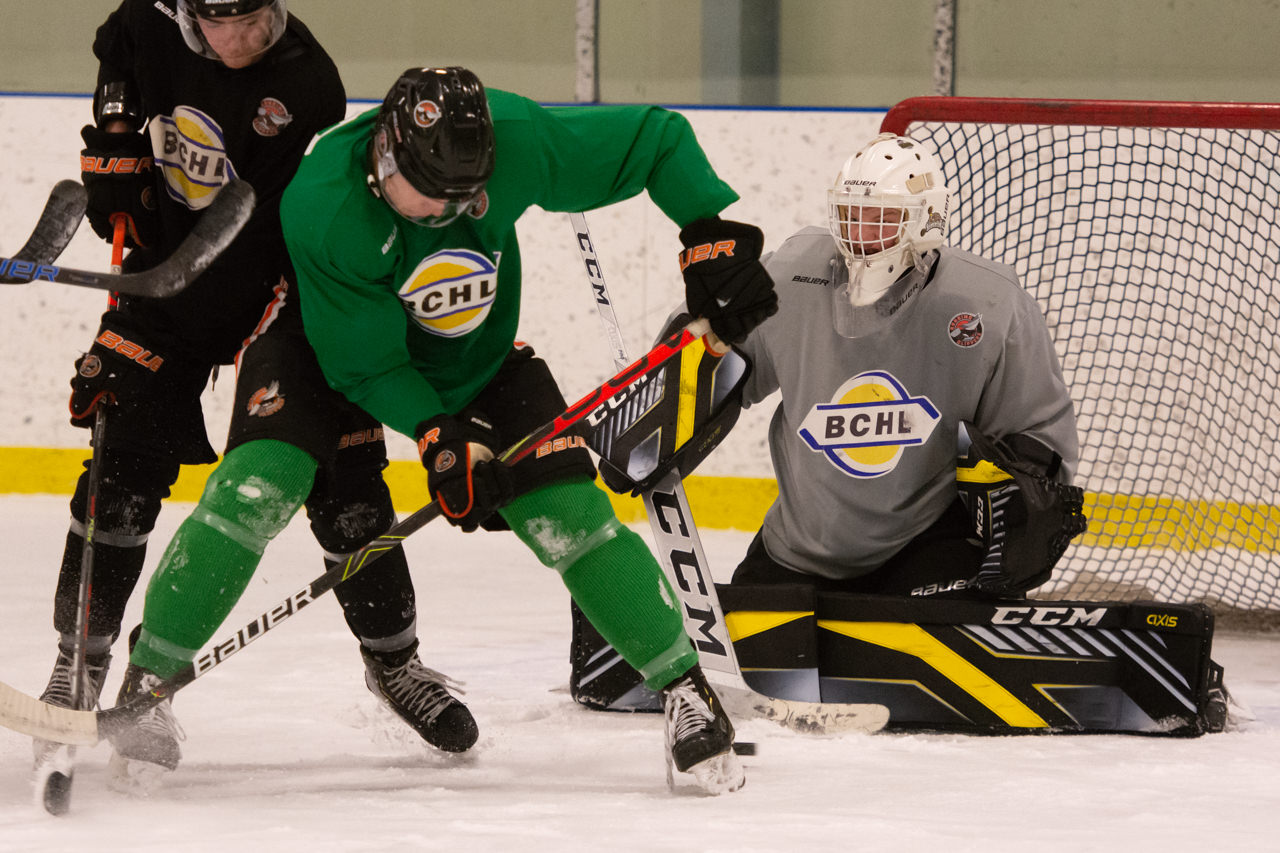
WHO IT’S FOR
Moving on from a Premier line that lived through seven generations — from the original Reebok P1 through P4, then the Reebok XLT, and finally the CCM Premier 1 and 2 over the past four years — and was worn by big names like Roberto Luongo was a bold move. But the reality is the game is changing, and so are goalie preferences, with the E-Flex line now accounting for roughly 75 percent of their sales and pro usage right up to the NHL. And after getting goalies who have worn both into the new AXIS, the early consensus is it works for both.
The fact a reactive professional goalie like Ferguson could transition so seamlessly from a long-time E-Flex goalie to wearing the new AXIS says a lot about achieving that balance.
“I like the way they sat on my leg,” Ferguson said. “It was comfortable.”
The reality is this move echoes a shift in preferences right up to the NHL, where some goalies began asking for a version of E-Flex that was stiffer from the shin up about three years ago. By giving goalies at every level access to those preferences — a flexible, mobile boot area that allows them to move and load with power, combined with a stiffer, more rigid face and active rebounds that buy them time to recover — CCM provides the best of both worlds.
The new AXIS pad can be worn loose for those coming from the Premier line that want their leg to move freely inside the pad, but the Quick Motion strapping also allows for a tighter fit in the shin for goalies that want a more connected feeling and prefer the pad to move with their leg, something that didn’t really fit as well with the old Premier line. The only thing a Premier holdout can’t still get is that steep boot break and pad sitting down to the ice in front of their skate. When you consider where the game is headed, it’s a tradeoff that makes sense.
Given our early feedback, especially from former E-Flex-wearing goalies who wouldn’t normally transition easily to a Premier pad, it’s a bold move more goalies will appreciate.
Comments
Let's talk goaltending!
We welcome your contribution to the comments on this and all articles at InGoal. We ask that you keep it positive and appropriate for all - this is a community of goaltenders and we're here for each other! See our comment policy for more information.



